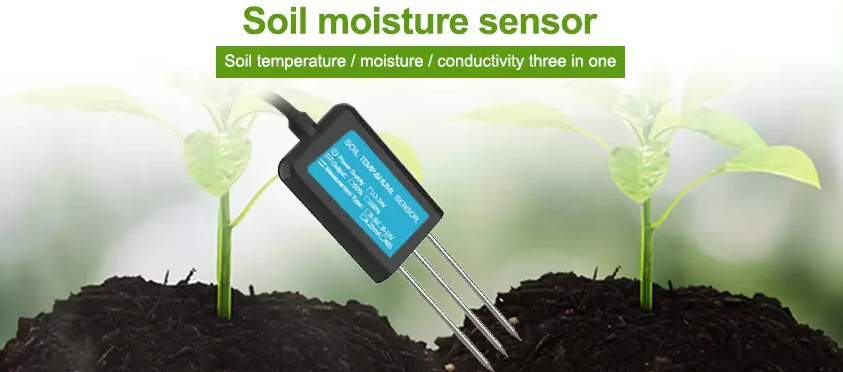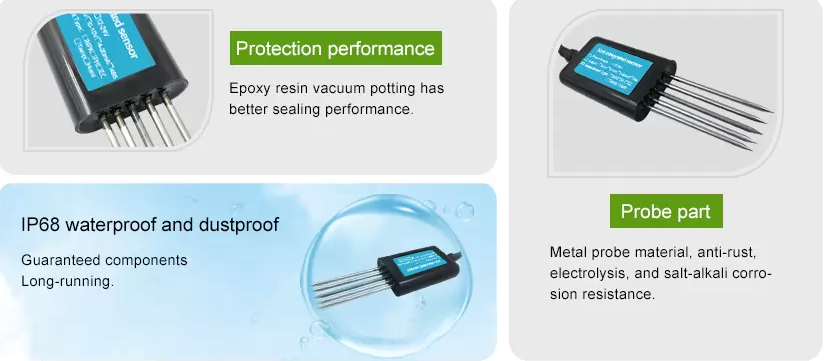What are soil moisture sensors for plant ?

Soil moisture sensors for plant are electronic devices used to measure soil moisture content, which represents the amount of water in the soil that is available for plant uptake. They provide data on soil moisture levels that can be used to optimize irrigation efficiency and determine the appropriate timing and amount of water and nutrients needed by crops. There are many types of soil moisture sensors available, each with their unique advantages and disadvantages. Some common types include:
- Tensiometers: These sensors measure the tension—or pull—of water within the soil. They consist of a ceramic tip and a vacuum gauge connected by tubing. Tensiometers are simple to use but must have periodic calibration and may require occasional cleaning.
- Gypsum blocks: These sensors use the principle that when the soil around the gypsum block dries out, nearby ions in the soil solution begin to concentrate, increasing the electrical conductivity between the two electrodes contained in the gypsum block. The conductivity then correlates with the soil’s moisture content. Gypsum blocks are widely used and have a low cost but require installation at a precise depth.
- Time Domain Reflectometry (TDR) sensors: These sensors emit electromagnetic pulses into the soil and then measure the time taken for the signal to be bounced back. The pulse transmission time correlates with the soil’s moisture content. TDR sensors are highly accurate but can be costly.
- Capacitance sensors: These sensors measure changes in the dielectric constant of the soil around them. As soil moisture increases, more water molecules will condense around the sensor, leading to a change in its electric charge. Capacitance sensors are affordable and easy to use but may require frequent calibration due to plant root interference.
soil moisture sensors for plant

Soil moisture plays a critical role in plant growth and development. Adequate soil moisture is essential for providing plants with the water needed to maintain proper physiological functions. Too much or too little moisture can lead to poor plant growth, reduced yields, and even crop failure. As a result, managing soil moisture is a crucial aspect of modern agriculture. Soil moisture sensors have become an essential tool for farmers and growers, allowing them to monitor moisture levels in real-time and make informed decisions regarding irrigation and nutrient management. In this article, we will explore the benefits of using soil moisture sensors for plants and how they can help improve agricultural productivity and sustainability.
Benefits of Soil Moisture Sensors:

Using soil moisture sensors for plants offers many benefits,
- Optimize irrigation efficiency: When farmers know precisely how much water their crops need, they can irrigate more efficiently. Soil moisture sensors allow farmers to apply the right amount of irrigation water at the appropriate time to prevent over or under-watering. This reduces water consumption and conserves water resources.
- Save Money: By optimizing irrigation, farmers and gardeners can save money on water usage costs. Additionally, with better data, they can reduce the amount of fertilizer and pesticide used, reducing overall costs associated with crop management while maximizing yield potential.
- Improve Plant Health: With real-time knowledge of soil moisture levels, farmers and homeowners can adjust their watering practices accordingly. This helps prevent disease development, improve plant root growth, and promote overall plant health.
- Reduce Environmental Impact: Over-irrigating plants can lead to soil erosion and nutrient depletion, negatively impacting the environment. By using soil moisture sensors, farmers and gardeners can target the specific areas that need watering, minimizing water run-off and pollution of local water systems.
- Increase Yield Potential: Soil moisture sensors allow farmers and growers to optimize irrigation schedules